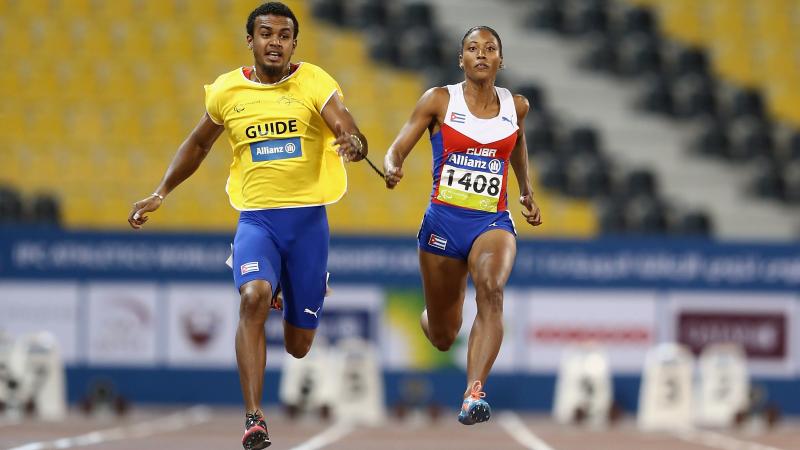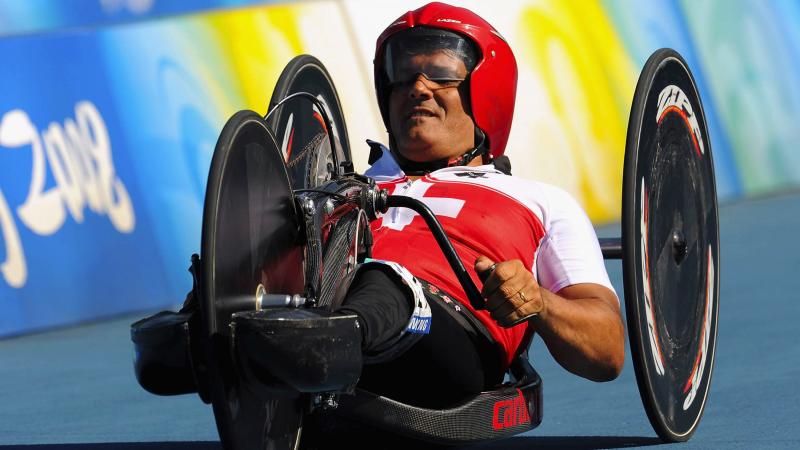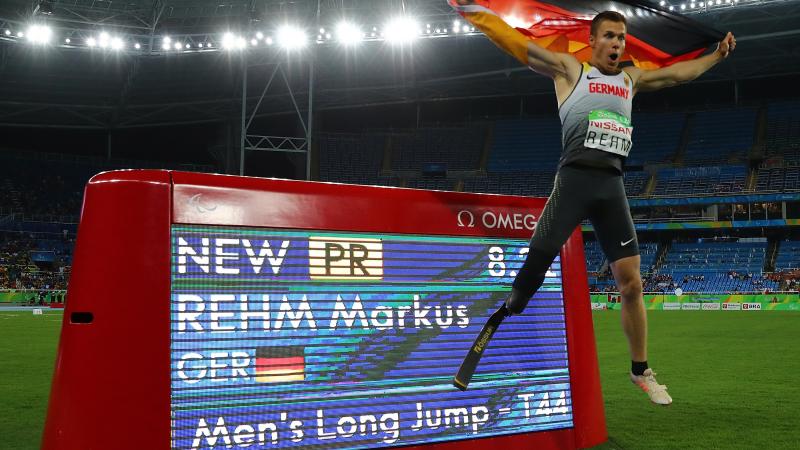HISTORY OF PARA ATHLETICS
Para athletics is the biggest sport within the Paralympic Movement in terms of the number of participating athletes and countries.
It was one of eight sports included in the first Paralympic Games in Rome, Italy, in 1960 and has remained on the programme ever since, consistently attracting the biggest crowds and TV audiences.
Today World Para Athletics, under the governance of the International Paralympic Committee, acts as the international federation for the sport and is based in Bonn, Germany.
Open to male and female athletes in all eligible impairment groups, Para athletics offers a wide range of competition opportunities. This includes the Paralympic Games which are held every four years, biennial World and World Junior Championships and biennial or quadrennial regional Championships.
Since 2013 an annual Grand Prix season has taken place featuring several meetings around the world and, from 2016 onwards, wheelchair racers have competed as part of the World Marathon Majors series.
Athletes compete according to their sport specific classification in each event. Some compete in wheelchairs and some with prostheses, while vision impaired athletes are supported by a sighted guide. To further increase the number of athletes with high support needs competing in the sport, the discipline of RaceRunning was included in World Para Athletics events from the start of 2018.
Para athletics is now practised internationally by athletes in more than 130 countries.
EQUIPMENT
Many Para athletics events require specific sport equipment such as the club, discus, shot put, and javelin. In addition, Para athletes may use certain assistive devices as specified in the World Para Athletics rules.
Wheelchairs are considered sports equipment in track and field events, and racing wheelchair tend to be very lightweight and aerodynamic.
Prosthetic devices may be used by amputees. These have been specifically developed to withstand the demands of sports competition. World Para Athletics rules require the use of leg prostheses in track events; however, the use of prostheses in field events is optional
Rope tethers or other devices may be used by runners with a vision impairment to link with their sighted guides. Acoustic devices (or a sighted "caller") may be used to indicate take-off in jumping events, throwing target areas, etc.
HISTORY
The first Para athletics competition was held in 1952 when several athletes with a spinal cord injury took part in a javelin event as part of the Stoke Mandeville Games which served injured World War II veterans.
At the Rome 1960 Paralympics, the Para athletics competition featured 31 athletes (21 men and 10 women) from 10 countries who took part in 25 medal events. The disciplines athletes competed in included shot put, javelin, precision javelin and club throw. There was also a medal event in men’s pentathlon comprising of archery, swimming, javelin, shot put and club throw. Italy topped the medals table with 32 medals. Maria Scutti won 11 medals for the host nation, including nine golds.
Four years later at the Tokyo 1964 Paralympics, the Para athletics programme expanded to 42 medal events. Wheelchair racing made its Paralympic debut with the dash, slalom and relay events all proving popular with spectators.
The Heidelberg 1972 Paralympic Games saw the Para athletics programme extend beyond just athletes with a spinal cord injury with the inclusion of demonstration events for blind athletes over 100m. Such was their success, full medal events for blind athletes, together with medal events for amputee athletes, formed part of the Toronto 1976 Paralympics.
Following the introduction of new specialised racing wheelchairs, race distances were extended beyond 100m, to include 200m, 400m, 800m and 1,500m.
At the Arnhem 1980 Paralympics, athletes with cerebral palsy joined amputee, blind, and spinal cord injured athletes for the first time.
The first marathon events were held at the 1984 Paralympics.
Switzerland’s Franz Nietlispach made history at Seoul 1988 winning eight medals, including six golds, the most ever by a track and field athlete since 1960.
His record was surpassed four years later when the USA’s Bart Dodson won eight gold medals in the TW1 class.
At the Rio 2016 Paralympics, the competition attracted 1,147 athletes from 147 National Paralympic Committees (NPCs), spanning all five continents. Female participation was by 19 per cent compared to London 2012 and there was also a 23 per cent increase in the number of high support needs athletes taking part.
The sport benefited from 357 hours of TV airtime according to post Rio 2016 figures from Nielsen, reaching a cumulative TV audience of 673 million people. A further 23.4 million people were reached by the sport’s social media channels.
For the Tokyo 2020 Paralympics, a new mixed gender, mixed class 4x100m relay has been introduced. The race involves teams of two male and two female Para athletes, each from a different class. Teams have a vision impaired athlete (T11-13), a wheelchair racer, an athlete from the T42-47 or T61-64 limb impairments classes and one from the T35-38 co-ordination impairments classes.
GROWTH OF ATHLETICS AT THE PARALYMPICS
| Year | Countries | Medal Events | Male | Female | Total | Top 3 countries |
|---|---|---|---|---|---|---|
| 1960 | 10 | 25 | 21 | 10 | 31 | 1: ITA 2: GER 3: GBR |
| 1964 | 19 | 42 | 166 | 72 | 238 | 1: USA 2: ITA 3: RSA |
| 1968 | 26 | 70 | 304 | 127 | 431 | 1: USA 2: ISR 3: ARG |
| 1972 | 39 | 73 | 379 | 171 | 550 | 1: USA 2: FRG 3: RSA |
| 1976 | 38 | 209 | 620 | 156 | 776 | 1: USA 2: FRG 3: MEX |
| 1980 | 40 | 274 | 687 | 250 | 937 | 1: USA 2: CAN 3: POL |
| 1984 | 51 | 449 | 888 | 314 | 1,202 | 1: USA 2: GBR 3: CAN |
| 1988 | 57 | 345 | 885 | 264 | 1,149 | 1: USA 2: FRG 3: GBR |
| 1992 | 74 | 215 | 723 | 205 | 928 | 1: USA 2: ESP 3: GER |
| 1996 | 85 | 210 | 711 | 197 | 908 | 1: USA 2: ESP 3: AUS |
| 2000 | 103 | 234 | 800 | 244 | 1,044 | 1: AUS 2: GBR 3: USA |
| 2004 | 116 | 194 | 766 | 298 | 1,064 | 1: CHN 2: AUS 3: CAN |
| 2008 | 111 | 160 | 696 | 332 | 1,028 | 1: CHN 2: AUS 3: RSA |
| 2012 | 141 | 170 | 759 | 374 | 1,133 | 1: CHN 2: RUS 3: GBR |
| 2016 | 146 | 177 | 695 | 445 | 1,140 | 1: CHN 2: GBR 3: UKR |
| 2020 | 155 | 167 | 653 | 489 | 1,142 | 1: CHN 2: RPC 3: USA |
ALL-TIME PARALYMPIC ATHLETICS MEDAL TABLE
| RANK | COUNTRY | GOLD | SILVER | BRONZE | TOTAL |
|---|---|---|---|---|---|
| 1 | USA | 385 | 389 | 368 | 1,142 |
| 2 | Great Britain | 213 | 173 | 187 | 573 |
| 3 | Canada | 200 | 168 | 168 | 534 |
| 4 | China | 187 | 142 | 99 | 378 |
| 5 | Australia | 157 | 164 | 165 | 486 |
TOP 5 MALE PARALYMPIC MEDALLISTS
| RANK | ATHLETE | YEARS COMPETING | GOLD | SILVER | BRONZE | TOTAL |
|---|---|---|---|---|---|---|
| 1 | Franz Nietlispach (SUI) | 1980-2000 | 14 | 6 | 1 | 21 |
| 2 | Bart Dodson (USA) | 1984-2000 | 13 | 3 | 4 | 20 |
| 3 | Heinz Frei (SUI) | 1984-2000 | 11 | 6 | 5 | 22 |
| 4 | Tim Sullivan (AUS) | 2000-2008 | 10 | 0 | 0 | 10 |
| 5 | Ron Stein | 1960-1964 | 9 | 0 | 0 | 9 |
TOP 5 FEMALE PARALYMPIC MEDALLISTS
| RANK | ATHLETE | YEARS COMPETING | GOLD | SILVER | BRONZE | TOTAL |
|---|---|---|---|---|---|---|
| 1 | Chantal Petitclerc (CAN) | 1992-2008 | 14 | 5 | 2 | 21 |
| 2 | Zipora Rubin-Rosenbaum (ISR) | 1964-1988 | 13 | 5 | 5 | 23 |
| 3= | Purificacion Santamarta (ESP) | 1980-2004 | 11 | 4 | 1 | 16 |
| 3= | Tanni-Grey Thompson (GBR) | 1988-2004 | 11 | 4 | 1 | 16 |
| 5 | Connie Hansen (DEN) | 1984-1992 | 9 | 4 | 1 | 14 |
Away from the Paralympic Games, the first World Championships were held in Berlin, Germany, in 1994. Since 2011 they have been held biennially with the next World Championships scheduled for Paris, France, in July 2023.
Assen, Netherlands, staged the first European Championships in 2003. From the 2012 in Stadskanaal, Netherlands, the event has taken place every two years. The most recent edition took place in Bydgoszcz, Poland, attracting nearly 700 athletes from 44 nations.
In the Americas and Asia, regional Para athletics competition form part of the multi-sport Parapan American Games and Asian Para Games which take place every four years.
The first World Junior Championships were held in 2017 in Nottwil, Switzerland, and will now take place biennially.

 Facebook
Facebook
 Instagram
Instagram
 Twitter
Twitter
 Youtube
Youtube







